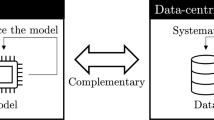Abstract
Intelligent information systems deploy applied ontologies or logic-based conceptual data models for effective and efficient data management and to assist with decision-making. A core deliberation in the design of such systems, is how to link the knowledge to the data. We recently designed a novel knowledge-to-data architecture (KnowID) which aims to solve this critical step through a set of transformation rules rather than a mapping layer, which operate between models represented in EER notation and an enhanced relational model called the ARM. This system description zooms in on the novel tool for the core component of the transformation from the Artificial Intelligence-oriented modelling to the relational database-oriented data management. It provides an overview of the requirements, design, and implementation of the modular transformations module that straightforwardly permits extension with other components of the modular KnowID architecture.




Similar content being viewed by others
Notes
The team members kindly permitted us to use and revise their code (by default they are the copyright holders).
References
Borgida A, Toman D, Weddell GE (2016) On referring expressions in information systems derived from conceptual modelling. In: Proc. of ER’16, LNCS, vol. 9974, pp 183–197. Springer
Braun G, Estevez E, Fillottrani P (2019) A reference architecture for ontology engineering web environments. J Comp Sci Tech 19(1):22–31
Calvanese D, Cogrel B, Komla-Ebri S, Kontchakov R, Lanti D, Rezk M, Rodriguez-Muro M, Xiao G (2017) Ontop: Answering SPARQL queries over relational databases. Sem Web J 8(3):471–487
Calvanese D, De Giacomo G, Lembo D, Lenzerini M, Rosati R (2007) Eql-lite: effective first-order query processing in description logics. In: Veloso MM (ed) IJCAI 2007, Proceedings of the 20th International Joint Conference on artificial intelligence, Hyderabad, India, January 6–12, 2007, pp 274–279
Davis I, Steiner T, Hors AJL (2013) RDF 1.1 JSON Alternate Serialization (RDF/JSON) (2013). http://www.w3.org/TR/rdf-json/. Accessed 26 June 2020
Dimou A, Sande MV (2014) RDF mapping language (RML). Unofficial draft, Ghent University (2014).http://rml.io/spec.html. Accessed 26 June 2020
Fillottrani PR, Keet CM (2014) Conceptual model interoperability: a metamodel-driven approach. In: Bikakis A, et al. (ed) Proc. of RuleML’14, LNCS, vol. 8620, pp 52–66. Springer
Fillottrani PR, Keet CM (2015) Evidence-based languages for conceptual data modelling profiles. In: Morzy T, et al. (ed) Proc. of ADBIS’15, LNCS, vol. 9282, pp 215–229. Springer
Fillottrani PR, Keet CM (2020) KnowID: an architecture for efficient knowledge-driven information and data access. Data Intell. https://doi.org/10.1162/dint_a_00060 (in print)
Gottlob G, Kikot S, Kontchakov R, Podolskii VV, Schwentick T, Zakharyaschev M (2014) The price of query rewriting in ontology-based data access. Artif Intell 213:42–59
Kontchakov R, Lutz C, Toman D, Wolter F, Zakharyaschev M (2010) The combined approach to query answering in dl-lite. In: Lin F, Sattler U, Truszczynski M (eds) Principles of knowledge representation and reasoning: proceedings of the Twelfth International Conference, KR 2010, Toronto, Ontario, Canada, May 9–13, 2010. AAAI Press
Krötzsch M, Rudolph S (2016) Is your database system a semantic web reasoner? Künstl Intell 30:169–176
Lubyte L, Tessaris S (2009) Automated extraction of ontologies wrapping relational data sources. In: Proc of DEXA’09, pp 128–142. Springer
Ma W, Keet CM, Oldford W, Toman D, Weddell G (2018) The utility of the abstract relational model and attribute paths in SQL. In: Faron Zucker C et al. (ed) Proc. of EKAW’18, pp 195–211. Springer
Noy N, Gao Y, Jain A, Narayanan A, Patterson A, Taylor J (2019) Industry-scale knowledge graphs: lessons and challenges. Queue 20(48–20):75 17(2)
Roy S, Suciu D (2014) A formal approach to finding explanations for database queries. In: Dyreson CE, Li F, Özsu MT (eds) International Conference on management of data, SIGMOD 2014, Snowbird, UT, USA, June 22-27, 2014, pp. 1579–1590. ACM. https://doi.org/10.1145/2588555.2588578
Thalheim B (2009) Extended entity relationship model. In: Liu L, Özsu MT (eds) Encyclopedia of database systems, vol 1. Springer, Berlin, pp 1083–1091
Toman D, Weddell GE (2011) Fundamentals of Physical design and query compilation. Synthesis lectures on data management. Morgan & Claypool Publishers, San Rafael
Toman D, Weddell GE (2014) On adding inverse features to the description logic \({CFD^{\forall }}_{{\rm nc}}\). In: Proc. of PRICAI’14, pp 587–599
Xiao G, Ding L, Cogrel B, Calvanese D (2019) Virtual knowledge graphs: an overview of systems and use cases. Data Intell 1:201–223
Acknowledgements
We would like to thank all the capstone students for their efforts, and in particular J. Du Plessis, St J. Grimbly, and G. Stein for their design and code. SJ and CMK acknowledge the partial support by the NRF of South Africa (Grant number 115376).
Author information
Authors and Affiliations
Corresponding author
Rights and permissions
About this article
Cite this article
Fillottrani, P.R., Jamieson, S. & Keet, C.M. Connecting Knowledge to Data Through Transformations in KnowID: System Description. Künstl Intell 34, 373–379 (2020). https://doi.org/10.1007/s13218-020-00675-6
Received:
Accepted:
Published:
Issue Date:
DOI: https://doi.org/10.1007/s13218-020-00675-6




